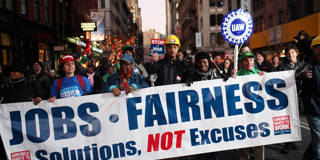Over the past half-century, globalization has narrowed the gap between rich and poor in the world as a whole. But the gap between rich and poor within Western democracies has widened, posing serious risks to the hard-fought gains of social and democratic reform movements over the past 200 years.
LONDON – Last month, I was invited to speak at the York Festival of Ideas, an annual forum for debating alternative, predominantly progressive policy goals. I talked about my work on asset-price stabilization. Andy Wood of the consultancy Grant Thornton spoke about inclusiveness in business, Neil McInroy of the Center for Local and Economic Strategies discussed local organizing, and Ander Etxeberria of the Mondragon Corporation told us about their employee-owned cooperatives in the Basque Country. But, most importantly, Wanda Wyporska of The Equality Trust gave a fascinating talk about the principle of “equality for all.”

LONDON – Last month, I was invited to speak at the York Festival of Ideas, an annual forum for debating alternative, predominantly progressive policy goals. I talked about my work on asset-price stabilization. Andy Wood of the consultancy Grant Thornton spoke about inclusiveness in business, Neil McInroy of the Center for Local and Economic Strategies discussed local organizing, and Ander Etxeberria of the Mondragon Corporation told us about their employee-owned cooperatives in the Basque Country. But, most importantly, Wanda Wyporska of The Equality Trust gave a fascinating talk about the principle of “equality for all.”